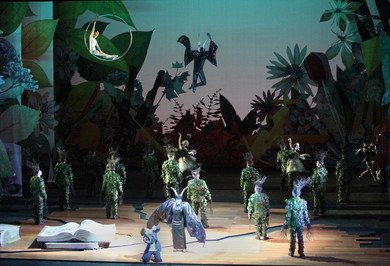New Stage
Premiere of this production: 19 Jan 2013 (Variations and Fugue on a Theme of Purcell)
The Young Person's Guide to the Orchestra, Op. 34, is a musical composition by Benjamin Britten in 1946 with a subtitle "Variations and Fugue on a Theme of Purcell". It was originally commissioned for an educational documentary film called The Instruments of the Orchestra, directed by Muir Mathieson and featuring the London Symphony Orchestra conducted by Malcolm Sargent. The work is one of the best-known pieces by the composer, and is one of the three popularly used scores in children's music education, together with Saint-Saлns' The Carnival of the Animals and Prokofiev's Peter and the Wolf. This work, in the composer's own words, is affectionately inscribed to the children of John and Jean Maud: Humphrey, Pamela, Caroline and Virginia, for their edification and entertainment.
Instrumentation The Young Person's Guide to the Orchestra is scored for the following large orchestra: Woodwinds: a piccolo, 2 flutes, 2 oboes, 2 clarinets in B flat and A, and 2 bassoons
Brass: 4 horns in F, 2 trumpets in C, 3 trombones (2 tenor and 1 bass), and a bass tuba Percussion: timpani, a bass drum, cymbals, a tambourine, a triangle, a snare drum, a wood block, a xylophone, castanets, a tamtam, and a whip. Structure The work is based on the Rondeau from Henry Purcell's incidental music to Aphra Behn's Abdelazer, and is structured, in accordance with the plan of the original documentary film, as a way of showing off the tone colours and capacities of the various sections of the orchestra. In the introduction, the theme is initially played by the entire orchestra, then by each major family of instruments of the orchestra: first the woodwinds, then the brass, then the strings, and finally by the percussion. Each variation then features a particular instrument in depth, in the same family order, and generally moving through each family from high to low. So, for example, the first variation features the piccolo and flutes; each member of the woodwind family then gets a variation, ending with the bassoon; and so on, through the strings, brass, and finally the percussion. After the whole orchestra has been effectively taken to pieces in this way, it is reassembled using an original fugue which starts with the piccolo, followed by all the woodwinds, strings, brass and percussion in turn. Once everyone has entered, the brass are re-introduced (with a strike on the gong) with Purcell’s original melody while the remainder continue the fugue theme until the piece finally comes to an end after building up to a fortissimo and Maestoso finish. The sections of the piece and instruments introduced by the variations are as follows.
© Bolshoi Theatre | ||||||||||


